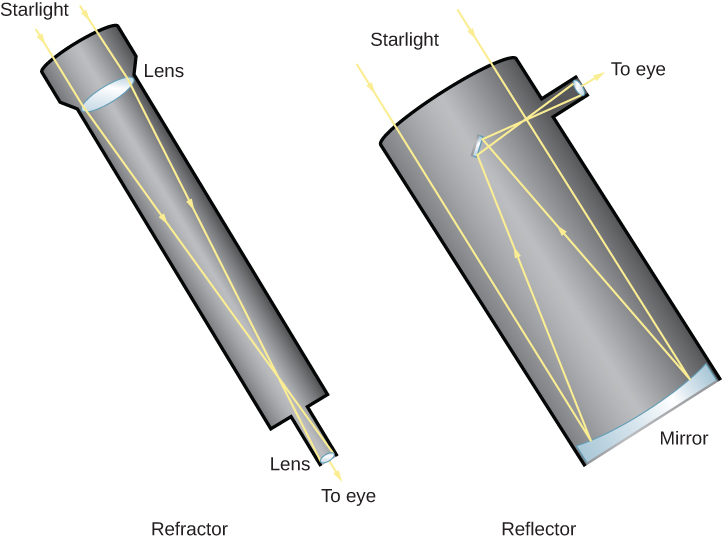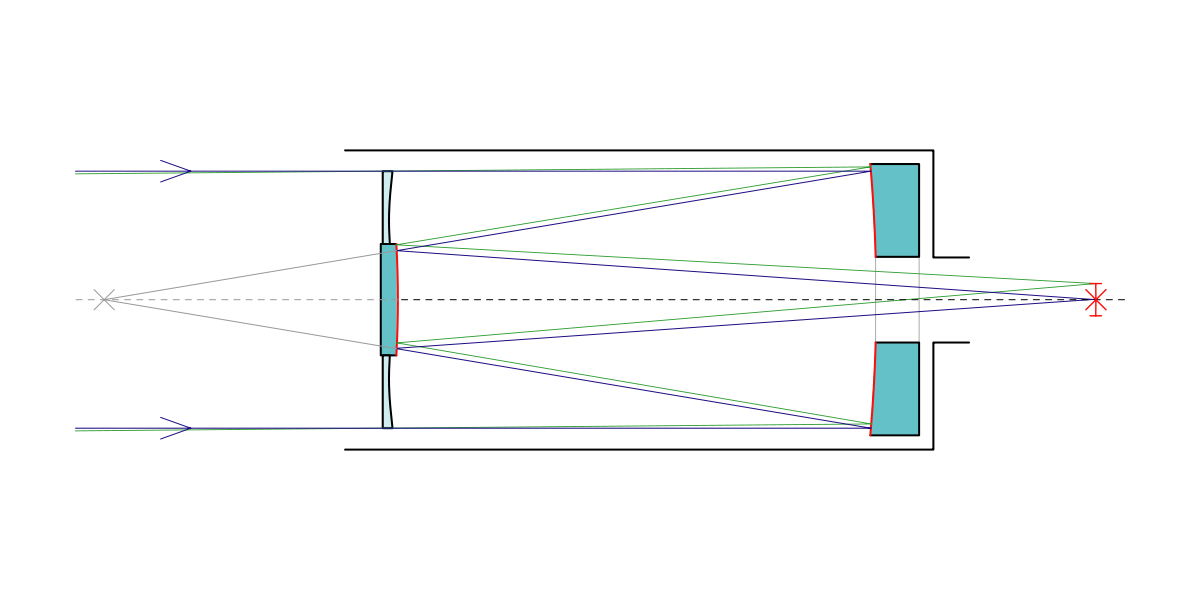More than anything else, your choice of optical tube assembly (OTA, aka, the telescope itself) will impact nearly every other aspect of astronomy for you, so picking the right one is important for success. Luckily there is also a decent used market for telescopes, so you can always sell it if you decide you want something different. Used scopes are also an affordable way to buy a telescope, but if you are new to the hobby and are buying from a stranger, ask someone knowledgeable to come along.
Most manufactures offer telescope bundles that include the mount, OTA, eye pieces and other accessories. Bundles are an affordable and easy way to get into astronomy and you can grow from there. More experience amateurs buy parts and pieces and put together a scope for their particular needs.
What follows is a brief introduction (yes, its long but it could be much longer) to the types of telescopes for visual astronomy you’ll run into and some of the terminology. We’ll cover astrophotography in a later post but we’d encourage you to check out AstroBackyard which has an incredible amount of information including how to get started.
Refractors
Refractor scopes have an objective lens at the end of a long tube and the eyepiece at the other end. People often associate the shape with spy glasses. Refracting telescopes, so called because the lenses refract, or bend, light passing through them, are excellent for viewing planets and the moon because of the high magnification and relatively low distortion. Refractors are good for planetary viewing and the moon because low distortion at high magnification is less than with other designs and the loss of light from brighter objects is less noticeable in refactors. Refractors come in two types, achromats and apochromats.
Achromats have two lenses that will focus two different wave lengths, usually red and blue on the same focal plane. Achromats suffer from chromatic dispersion, seen as a purple fringe in the edges of the lenses. Modern coatings have reduce chromatic dispersion a great deal and usually isn’t a bother for visual astronomers. Apochromats have three lenses that focus red, blue, and green on the same focal plane and are usually only used by astrophotographers looking to shoot true color images. APO’s are two element achromats that have really good lens coatings that rival apochromats, but since they are two element designs, they can’t be called apochromats.
Amateurs are usually limited to refractors with an aperture of 6 inches or less. Above 6 inches and the costs sky rocket because the manufacturing costs of high quality lenses is high and the mechanical engineering of the OTA to support the weight of glass without bending is expensive. Refractors are generally more expensive than either reflectors and Catadioptrics. The focal length of the refractor is measured from the front of the objective to the focal plane.

Reflectors
Reflector telescopes are relatively simple optical designs that use shaped mirrors to collect and magnify light. The are called Newtonian telescopes after Sir Isaac Newton, who is credited with making the first reflector telescope. Reflectors are also called Dobsonians after John Dobson who was instrumental in bringing astronomy to the masses with low cost telescope designs DIYers could make. Dobsonian technically refers to the rocker box mount, but it’s common for people to refer to the reflector telescope on a rocker box mount as a “Dobsonian” telescope. We’re going to call them reflectors for the sake of clarity.
Reflectors that are 8 inches and larger are referred to as light buckets because of their light collection abilities, which is one of the top features in a telescope. Amateurs looking for better viewing have bought or built reflectors beyond 24in in diameter. These are huge scopes, often on fixed mounts and you need a ladder or a raised platform to get to the eye piece. Reflectors are good for viewing DSOs because of their ability to collect and concentrate a lot of light with low distortion compared to refractors.
Reflectors do suffer from spherical aberrations where stars are out-of focus at the edge of the eye piece and coma distortion where stars appear elongated. Spherical aberrations can be minimized with parabolic shaped mirrors. Reflectors have a secondary mirror which directs light out the side of the scope and is attached with 3-4 vanes of thin metal. Those veins create diffraction spikes when viewing bright objects like stars. Unlike refractor telescopes, reflectors need regular adjustment, called collimation, to get the best image. Collimation is the process of aligning the mirrors in the optical train so they are reflecting perfectly. It takes only a few minutes to collimate a whacked out optical train.
Reflectors are OK with planetary objects but due to distortion, and ironically, the light collection is so good that planetary objects can be too bright for easy viewing. A polarizing filter can lower brightness and increase contrast, however. The focal length of a reflector is measured as the distance from the primary mirror, to the secondary mirror, and then to the focal plane. Reflectors can be built with a solid tube of metal or fiberglass that contains all the elements within. Reflectors are also built using truss tube assemblies have a primary mirror box, a secondary mirror box and are connected using truss rods or tubes. The result is a large aperture reflector telescope–well beyond 12 inches–that is still portable, though some field assembly is required. If you want a big, portable light bucket, don’t let the seeming complexity of a truss tube design discourage you. They are not hard to assemble even in the dark once you know how.
Reflectors can be very low cost compared to other types of telescopes of the same aperture and focal ratio (think brightness), which is the ratio of the focal length and the aperture. Examples of focal ratio are F5 or F10. An object viewed in a F5 telescope will be brighter than in an F10. Reflectors 6 inches and under can use a tripod based mount which may be motorized and computerized (aka, Go-To), though they are prone to swaying in the wind. Above 6 inches and the reflecting telescope is either on a permanent mount, like our 16in scope at DHO, or uses a rocker box mount. Larger reflector telescopes usually aren’t motorized and are called push-tos.
Catadioptrics
Catadioptric telescopes use a folded light path design and optical element from both refractors like the corrector plate on the front of the OTA and mirrors, like those in a reflector, to create a long focal length in a short space. Schmidt Cassegrain Telescopes (SCT) are the most common design but others like Maksutkov Cassegrains and Ritchey–Chrétien are popular as well. Telescopes using this design are usually referred to by their specific design like SCT or Mak.

All catadioptrics share a basic design. The front corrector plate reduces spherical aberration by bending the light paths before they hit the primary mirror correcting for the errors built into a spherical primary mirror. The light is then bounced to the secondary mirror and finally through a hole in the primary to the focal plane and the eye piece. Since the light is altered at the corrector plate, the measurement of the focal length starts there. Unlike reflecting telescopes, Catadioptrics don’t have diffraction spikes because the secondary mirror is mounted in the plate and there is no need for vanes to hold it in place. Various catadioptric telescope designs use shaped mirrors to correct for spherical aberration, coma, and other degradation.
Catadioptrics tend to have higher focal ratios leading to dimmer objects when viewed through the eye piece. The higher focal ratio is more impactful when looking at extended objects like nebulae and galaxies that are rather faint when compared to a faster reflector or refractor. However there some of mitigating benefits of modern catadioptrics.
Because the OTAs are smaller and lighter than others telescopes of similar aperture and focal length, catadioptrics are often sold with motorized and computerized go-to mounts that can find and track celestial objects. Sitting at an eye piece trying to discern a faint object is much easier when you don’t have to worry about whether you are actually in the right place or tracking the object. Catadioptrics are also less maintenance than reflectors usually only need the occasional collimation even when transporting the telescope to viewing locations. However, since catadioptrics are enclosed, it can often take 30-60 minutes for the telescope to equalize temperature with out side air (otherwise air currents from the hotter scope will impact the view). If you are viewing on cool or cold nights like we have in Central New York, the front corrector plate can dew or frost over.
Finally, while catadioptrics are smaller and lighter than comparable reflectors and refractors, they can be quite heavy and unwieldy on to carry and assemble in the dark. Like in the discussion on reflecting telescopes, be sure the scope you choose is one you will be willing to carry around and use, rather than dread dragging it outside. Better to give up some aperture for a scope you will use than to buy a light bucket that sits in your garage.
Solar Scopes
Solar scopes are specialized telescopes for looking safely at the sun. Using a variety of extremely dark filters, solar scopes dim the light through the optical train, enhance contrast so you can see details, and magnify the solar image. These are fun, but expensive telescopes but they are sure to get a rise from friends and family.
After market solar filters are available for the telescopes we describe above and are moderately priced, but buy they from a reputable source.
Binoculars
Binoculars are also used for star gazing and the sets with large apertures are ideal for wide field viewing of the starfield and a few of the brightest extended objects like Orion Nebula. They are also excellent for viewing star clusters. Celestial binoculars range from inexpensive sets costing $70-$100 dollars to sets that are $1,000 or more. Bear in mind as well that you will need to buy two eyepieces, filters, and so forth. Binoculars are a good choice if you’ll use them for multiple purposes like bird watching and other terrestrial viewing as well as casual star gazing. However, you will quickly run up against limitations of what you can see even compared to a lower cost telescope.
If you do get binoculars, also plan on getting a tripod and even a trapezoid mount. The lens to make decent quality large aperture binoculars suitable for astronomy makes them very heavy. Above 15x magnification, hand holding is very difficult to do while being able to see anything. Your heart beat will cause the image to jump. Also, the angle of looking up while standing next to a tripod means you will need a vary tall tripod to get the eyepieces over your head. Instead, look for binoculars that have 45 or 90 degree diagonals that bend the light path and make tripod use much more comfortable.
Bio
Mike Fratto is an amateur astronomer who can be found in his backyard or at Darling Hill Observatory on the rare nights its clear in Central New York.
